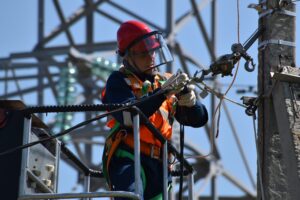Summary: OSHA regulations protect electrical workers by setting clear safety standards and requiring proper training. From de-energizing circuits to using PPE, these rules reduce risks, improve on the job safety, and keep projects moving without unnecessary delays.
When you’re learning a trade like electrical work, there’s a lot to take in. You’re gaining hands-on skills, discovering how systems work, and figuring out how to be part of a team on real job sites. But one thing gets emphasized again and again, whether you’re in a classroom, lab, or on the job: safety.

At first, safety might feel like a list of extra steps, a lot of gear, and a lot of extra paperwork, but once you’re on the job, it becomes clear: safety is what makes everything else possible. It keeps the work moving, protects your team, and makes sure everyone gets to go home at the end of the day.
But how is safety actually regulated? Who decides what counts as “safe” on a job site, and how do you know your employer is doing the right thing? That’s where OSHA comes in.
What is OSHA?
The Occupational Safety and Health Administration (OSHA) was created by Congress in 1970. Its mission is to make sure every worker in the U.S. has a safe, healthy workplace.
OSHA’s job is to set safety standards, inspect workplaces, and hold employers accountable. It also provides education, outreach, and training resources for both companies and workers.
But OSHA doesn’t just enforce regulations, it defines what safe work looks like. Without OSHA, safety expectations would vary wildly between employers, jobsites, and states.
How OSHA Supports Safe Electrical Work
Electrical work is complex. It involves systems that are powerful, often hidden, and sometimes unpredictable. That’s why OSHA has detailed regulations that cover both how systems are built and how people work with them. Some key areas include:
- De-energizing circuits before work starts
- Lockout/tagout procedures to prevent equipment from being turned on accidentally
- Personal protective equipment (PPE) such as gloves, eyewear, and insulated tools
- Fall protection when working on ladders, lifts, or scaffolding
- Training requirements that ensure workers know the risks and how to avoid them
- Qualified worker designation that limits certain tasks to those with proper training and authorization
- Clearances and approach boundaries that define safe distances from energized parts based on voltage levels
These rules help take the guesswork out of safety. They provide a structure for crews and employers to follow, making job sites more predictable and more secure.
What OSHA Regulations Mean for Electrical Apprentices and Workers
For new apprentices, OSHA regulations shape your training from day one. The safety talks you attend, the checklists you follow, the gear you wear — all of that traces back to OSHA requirements.
But it’s not just about staying “in compliance.” OSHA creates a common language for safety. Everyone on the jobsite knows what’s expected and understands what “safe” looks like. That consistency builds trust, improves communication, and helps crews work more efficiently.
Even more important: OSHA holds employers responsible. It’s not up to individual workers to guess what’s safe or figure it out on their own. Employers are legally required to provide training, equipment, and a safe work environment. That’s a big deal, especially for young workers just getting their start.
You might be wondering: but don’t OSHA’s regulations slow work down? No! Quite the opposite, actually: they make work possible, prevent injuries that stop work altogether, and, most importantly, help make sure everyone goes home at the end of the day.
Build Your Future, Safely and Confidently
If you’re thinking about a career in the electrical trades, safety will be part of everything you do, from your first day of apprenticeship to your last day on the job. Understanding OSHA’s role is just one piece of the bigger picture.
The electrical trades offer strong career opportunities, hands-on work, and the chance to be part of something purposeful and meaningful. Ready to take the next step?
Fill out our contact form to get connected and receive information about apprenticeship opportunities.
